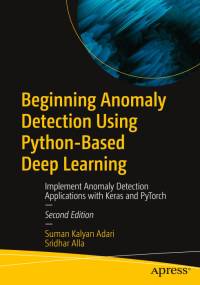Beginning Anomaly Detection Using Python-Based Deep Learning
- Indbinding:
- Paperback
- Sideantal:
- 548
- Udgivet:
- 2. januar 2024
- Udgave:
- 24002
- Størrelse:
- 178x30x254 mm.
- Vægt:
- 1018 g.
- Ukendt - mangler pt..
Normalpris
Abonnementspris
- Rabat på køb af fysiske bøger
- 1 valgfrit digitalt ugeblad
- 20 timers lytning og læsning
- Adgang til 70.000+ titler
- Ingen binding
Abonnementet koster 75 kr./md.
Ingen binding og kan opsiges når som helst.
- 1 valgfrit digitalt ugeblad
- 20 timers lytning og læsning
- Adgang til 70.000+ titler
- Ingen binding
Abonnementet koster 75 kr./md.
Ingen binding og kan opsiges når som helst.
Beskrivelse af Beginning Anomaly Detection Using Python-Based Deep Learning
This beginner-oriented book will help you understand and perform anomaly detection by learning cutting-edge machine learning and deep learning techniques. This updated second edition focuses on supervised, semi-supervised, and unsupervised approaches to anomaly detection. Over the course of the book, you will learn how to use Keras and PyTorch in practical applications. It also introduces new chapters on GANs and transformers to reflect the latest trends in deep learning.
Beginning Anomaly Detection Using Python-Based Deep Learning begins with an introduction to anomaly detection, its importance, and its applications. It then covers core data science and machine learning modeling concepts before delving into traditional machine learning algorithms such as OC-SVM and Isolation Forest for anomaly detection using scikit-learn. Following this, the authors explain the essentials of machine learning and deep learning, and how to implement multilayer perceptrons for supervised anomaly detection in both Keras and PyTorch. From here, the focus shifts to the applications of deep learning models for anomaly detection, including various types of autoencoders, recurrent neural networks (via LSTM), temporal convolutional networks, and transformers, with the latter three architectures applied to time-series anomaly detection. This edition has a new chapter on GANs (Generative Adversarial Networks), as well as new material covering transformer architecture in the context of time-series anomaly detection.
After completing this book, you will have a thorough understanding of anomaly detection as well as an assortment of methods to approach it in various contexts, including time-series data. Additionally, you will have gained an introduction to scikit-learn, GANs, transformers, Keras, and PyTorch, empowering you to create your own machine learning- or deep learning-based anomaly detectors.
What You Will Learn
Understand what anomaly detection is, why it it is important, and how it is applied
Grasp the core concepts of machine learning.
Master traditional machine learning approaches to anomaly detection using scikit-kearn.
Understand deep learning in Python using Keras and PyTorch
Process data through pandas and evaluate your model's performance using metrics like F1-score, precision, and recall
Apply deep learning to supervised, semi-supervised, and unsupervised anomaly detection tasks for tabular datasets and time series applications
Who This Book Is For
Data scientists and machine learning engineers of all levels of experience interested in learning the basics of deep learning applications in anomaly detection.
Beginning Anomaly Detection Using Python-Based Deep Learning begins with an introduction to anomaly detection, its importance, and its applications. It then covers core data science and machine learning modeling concepts before delving into traditional machine learning algorithms such as OC-SVM and Isolation Forest for anomaly detection using scikit-learn. Following this, the authors explain the essentials of machine learning and deep learning, and how to implement multilayer perceptrons for supervised anomaly detection in both Keras and PyTorch. From here, the focus shifts to the applications of deep learning models for anomaly detection, including various types of autoencoders, recurrent neural networks (via LSTM), temporal convolutional networks, and transformers, with the latter three architectures applied to time-series anomaly detection. This edition has a new chapter on GANs (Generative Adversarial Networks), as well as new material covering transformer architecture in the context of time-series anomaly detection.
After completing this book, you will have a thorough understanding of anomaly detection as well as an assortment of methods to approach it in various contexts, including time-series data. Additionally, you will have gained an introduction to scikit-learn, GANs, transformers, Keras, and PyTorch, empowering you to create your own machine learning- or deep learning-based anomaly detectors.
What You Will Learn
Understand what anomaly detection is, why it it is important, and how it is applied
Grasp the core concepts of machine learning.
Master traditional machine learning approaches to anomaly detection using scikit-kearn.
Understand deep learning in Python using Keras and PyTorch
Process data through pandas and evaluate your model's performance using metrics like F1-score, precision, and recall
Apply deep learning to supervised, semi-supervised, and unsupervised anomaly detection tasks for tabular datasets and time series applications
Who This Book Is For
Data scientists and machine learning engineers of all levels of experience interested in learning the basics of deep learning applications in anomaly detection.
Brugerbedømmelser af Beginning Anomaly Detection Using Python-Based Deep Learning
Giv din bedømmelse
For at bedømme denne bog, skal du være logget ind.
Find lignende bøger
Bogen Beginning Anomaly Detection Using Python-Based Deep Learning findes i følgende kategorier:






